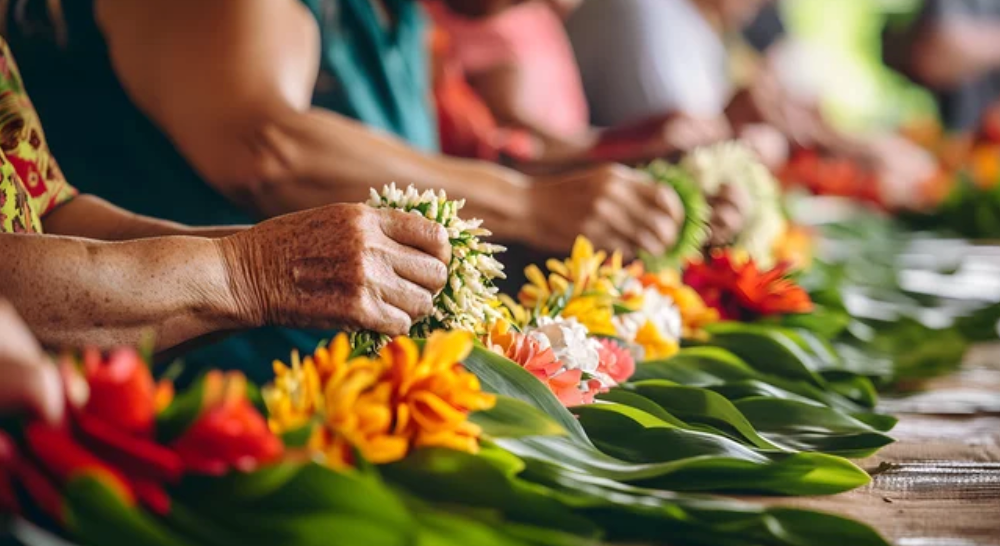
Hawaiian flowers are known for their vibrant colors and intoxicating fragrances
Hawaiian flowers are known for their vibrant colors and intoxicating fragrances. Here are some of the most amazing Hawaiian flowers celebrated for their delightful scents:
1. Plumeria (Frangipani)
- Scent: Sweet, fruity, and floral.
- Details: Plumeria is iconic in Hawaii and often used in leis. Its rich fragrance intensifies in the evening. The flowers come in shades of white, pink, yellow, and red.
2. Tuberose (Polianthes tuberosa)
- Scent: Intense, sweet, and creamy.
- Details: This flower emits a powerful aroma, especially at night. It is frequently used in lei-making and perfumes.
3. Gardenia (Kiele)
- Scent: Strong, sweet, and creamy.
- Details: Known for its pure white blossoms and glossy leaves, gardenia has a romantic fragrance that is widely used in Hawaiian perfumes and oils.
4. Pikake (Jasmine Sambac)
- Scent: Soft, sweet, and slightly spicy.
- Details: Pikake is a type of jasmine cherished for its delicate scent. It's popular for leis and traditional Hawaiian wedding ceremonies.
5. Hawaiian White Ginger (Awapuhi Ke’oke’o)
- Scent: Spicy, sweet, and refreshing.
- Details: This flower grows in lush tropical areas and its scent is often infused in shampoos and lotions.
6. Puakenikeni (Fagraea berteroana)
- Scent: Sweet, rich, and intoxicating.
- Details: The puakenikeni flower turns from creamy white to orange as it ages. Its scent grows stronger over time and is a popular choice for leis.
7. Hawaiian Hibiscus (Ma’o Hau Hele)
- Scent: Light and subtle.
- Details: While hibiscus is better known for its visual appeal, some varieties, like the yellow hibiscus, have a light fragrance.
8. Red Ginger (Awapuhi ‘Ula‘ula)
- Scent: Subtle, with hints of spice.
- Details: This vibrant flower is more subtle in scent but its beauty is striking and often used for tropical arrangements.
9. Stephanotis (Pua Male)
- Scent: Soft, sweet, and rich.
- Details: Also known as the Hawaiian wedding flower, Stephanotis is prized for its delicate, sweet fragrance and association with love and marriage.
10. Ilima (Sida fallax)
- Scent: Light and fresh.
- Details: Although the fragrance is subtle, ilima flowers are traditionally used in leis for royalty and special occasions.
Each of these flowers holds cultural significance in Hawaii and adds a unique touch to the island’s sensory experience.
Hawaiian flowers carry deep cultural significance, often representing love, respect, spirituality, and the connection between people and nature. They play essential roles in ceremonies, celebrations, and daily life. Here’s a closer look at the cultural importance of some iconic Hawaiian flowers:
1. Plumeria (Frangipani)
- Symbolism: Positivity, new beginnings, and birth.
- Cultural Role: Plumeria flowers are commonly used in leis, which symbolize welcome, friendship, and affection. In Hawaiian culture, wearing a plumeria behind the left ear signifies that someone is taken, while wearing it on the right indicates they are single.
2. Pikake (Jasmine Sambac)
- Symbolism: Love, romance, and devotion.
- Cultural Role: Pikake is often associated with Hawaiian royalty, especially Princess Kaʻiulani, who adored the flower. It is frequently used in leis for weddings and other romantic occasions.
3. Tuberose (Polianthes tuberosa)
- Symbolism: Purity and sensuality.
- Cultural Role: Tuberose leis are considered luxurious and are often reserved for special events, celebrations, and honoring guests. Its fragrance is believed to bring a sense of calm and joy.
4. Gardenia (Kiele)
- Symbolism: Purity, peace, and love.
- Cultural Role: Gardenia flowers are often worn as hair adornments during celebrations or significant life events. They are also used in traditional Hawaiian medicine and healing practices.
5. Puakenikeni (Fagraea berteroana)
- Symbolism: Transformation and affection.
- Cultural Role: The name "puakenikeni" means "ten-cent flower," reflecting its value in lei-making in earlier times. Its color-changing nature (from white to yellow to orange) symbolizes the evolving beauty of life.
6. Hawaiian White Ginger (Awapuhi Ke’oke’o)
- Symbolism: Healing and renewal.
- Cultural Role: Awapuhi is significant in traditional Hawaiian medicine. The plant’s juice is used as a natural hair and skin conditioner, symbolizing physical and spiritual cleansing.
7. Red Ginger (Awapuhi ‘Ula‘ula)
- Symbolism: Strength and resilience.
- Cultural Role: Red ginger is used in ceremonial offerings and hula performances. It represents vitality and the life force within nature.
8. Stephanotis (Pua Male)
- Symbolism: Marital bliss and good fortune.
- Cultural Role: Known as the Hawaiian wedding flower, it is used in bridal leis and bouquets. Its association with love and marriage reflects the flower’s role in fostering harmony.
9. Ilima (Sida fallax)
- Symbolism: Royalty and prosperity.
- Cultural Role: The ilima flower was historically reserved for Hawaiian aliʻi (chiefs). It is considered a lei of honor and respect, requiring hundreds of blossoms to make a single lei.
10. Hawaiian Hibiscus (Ma’o Hau Hele)
- Symbolism: Delicate beauty and respect.
- Cultural Role: As the state flower of Hawaii, the yellow hibiscus represents the spirit of the islands. Hibiscus flowers are used in offerings, decorations, and to show hospitality.
General Cultural Significance of Flowers in Hawaii:
-
Leis: Giving and receiving a lei symbolizes aloha (love, peace, and compassion). Leis are worn during graduations, weddings, and celebrations to show appreciation and respect.
-
Offerings to Nature: Flowers are often used in spiritual offerings to Hawaiian deities and ancestors.
- Hula and Chanting: Flowers adorn dancers, enhancing the storytelling through their fragrance and visual appeal.
Flowers in Hawaii are more than just beautiful; they represent the essence of the islands’ culture, connecting people to nature, each other, and the divine.
